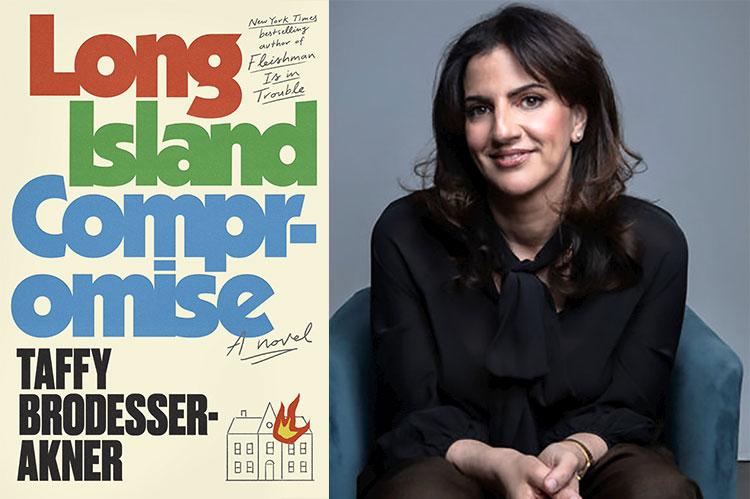“Long Island Compromise”
Taffy Brodesser-Akner
Random House, $30
After her smash hit “Fleishman Is in Trouble,” Taffy Brodesser-Akner is back, trying to avoid the sophomore slump with a new novel, “Long Island Compromise.” The book begins with the kidnapping of Carl Fletcher, a very wealthy businessman, from his Long Island driveway as he’s about to head to work. His family is contacted, ransom money is amassed, and Carl is dumped at a gas station on the Northern State Parkway five days after he is taken.
He’s bruised and filthy, but otherwise healthy.
The Fletchers, including Carl’s wife, Ruth, and young children, Bernard, Nathan, and Jenny, hope to ease back into a normal life. But the effects of the abduction shake up the family for decades.
The book is set in the fictional Long Island town of Middle Rock. The Fletchers have a 16-acre estate there, thanks to the Styrofoam manufacturing business Carl’s father, Zelig, launched after immigrating from Poland. A quick hop from Manhattan, with tons of money and a view of the Sound, Middle Rock sounds like Sands Point or Kings Point.
Ms. Brodesser-Akner writes about Zelig discovering Middle Rock: “He had been in America for years by then. When he arrived at what is now known as Cobbleway Park, he realized he’d gone too far. He got out of his car, and looked out onto the Sound. He heard the wind whispering to the trees, and beyond that he heard nothing, and, for the first time, he didn’t miss Poland, or at least the Poland of his childhood. He saw how he could live and be happy in this place.”
“Long Island Compromise” has a unique setup. A couple chapters detail the kidnapping and introduce the family, before Bernard, Nathan, and Jenny get their own long sections, Ms. Brodesser-Akner detailing their lives as adults and how the kidnapping likely prevented them from having happy, healthy, and normal lives.
Bernard, known as Beamer, is a screenwriter in Los Angeles. He had a hit film years before, but not much since. The screenplays he writes typically feature a kidnapping, and do not advance to the film stage. He’s a drug addict who seems to spend as much time with his BDSM prostitute pals as with his wife and children.
Some 116 pages later, it is Nathan’s turn. He’s a lawyer and a worrier, scared to death of dying, and the father of twins.
Ninety pages after that, Jenny gets her turn. Born just after her father’s kidnapping, she wants no part of the family’s wealth, donating giant amounts, and working as a union organizer to help the working class and make life more difficult for the overlords.
It was a little jarring to abruptly say goodbye to one of the children after reading a long section about them. But Ms. Brodesser-Akner tells their stories in a manner where, before long, you’re as wrapped up in Jenny’s story as you were in Nathan’s or Bernard’s.
Ruth gets a section too. She’s relentlessly disappointed by her children, and her negativity knows no bounds. She has a habit by which, if Beamer is talking about movies, she’ll dismissively say, “What’re you, Siskel and Ebert?” Or another child attempting armchair psychology gets, “What’re you, Dr. Joyce Brothers?”
Ruth gets irritating over time.
Carl, for his part, does not get his own section, and I would’ve liked one. Carl is the main character in the book’s opening pages, when he is snatched. His influence permeates every nook of the novel, but his character gets little time in the spotlight.
You’re probably wondering about the book’s title. A Long Island Compromise is a sex act, but not the sex act. A teen friend of Beamer’s and another pal were hooking up with a couple of teen girls, and the girls, determined to hold onto their virginity, dub their alternative act the Queens Compromise, based on where it happens (Douglaston, if you’re scoring at home), which becomes the Long Island Compromise because the boys are Jewish, according to one of the girls.
Does it make sense? No, but Long Island teens hooking up back in the day rarely did.
Ms. Brodesser-Akner takes a big swing with “Long Island Compromise.” Maybe too big — the book could’ve used a substantial trimming. She loves and loathes the Fletchers. Theirs is a dark story, but the author injects loads of humor into it.
As “Long Island Compromise” winds down, Ms. Brodesser-Akner writes of the Fletcher patriarch, “The last thing Carl saw on this Earth before he closed his eyes were the anguished faces of the people who had loved him the most in the world — the people who fretted over him and lived symbiotically with him and existed with him inside the unique syzygy that is a family.”
Few authors can use syzygy in a sentence, and fewer still could deliver a novel as weird, as dark, or as fun as “Long Island Compromise.”
Taffy Brodesser-Akner, a staff writer for The New York Times Magazine, will be at BookHampton in East Hampton on Friday at 5 p.m.
Michael Malone, a native Long Islander, has written for Westchester magazine and The Philadelphia Inquirer.

